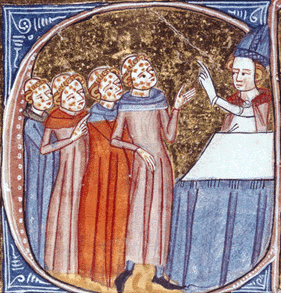...Best of Sicily presents... Best of Sicily Magazine. ... Dedicated to Sicilian art, culture, history, people, places and all things Sicilian. |
by Vincenzo Salerno | ||
Magazine Index Best of Sicily Arts & Culture Fashion Food & Wine History & Society About Us Travel Faqs Contact Map of Sicily |
The arrival of the plague in western Europe occurred in October 1347, when Genoese ships en route from the Crimea region docked at Messina. The disease, caused by the bacterium Yersinia pestis, was transmitted with fleas (Xenopsylla cheopis) infesting black rats (but also certain other animals). Humans were usually infected when bitten by these fleas. Bubonic plague is fatal (though there is now a cure) and leads to an infection of the lymph nodes, which become swollen (bubo is Latin for "bump"). Here's what actually happens. The bacteria grow inside the flea, causing conditions which block the insect's stomach and induce extreme hunger. The flea starts to feed on a host, and in this way the disease spreads. Boccaccio, Plutarch and Chaucer all mention the Black Death in their literary works. The disease made short life spans even shorter. Radically depleting the population in a short time, the plague greatly changed life in western Europe. In countries where serfs were tied to the land (the feudal system), it created an economy in which farmers became independent, able to earn more for their labour. This was less evident in Sicily, where fourteenth-century feudalism did not always entail serfdom per se. In eastern Europe kings and feudal lords eventually reasserted their power over the peasants. But the plague itself did not discriminate based on social rank. Such mass suffering did not result in better sanitary conditions --though, contrary to popular belief, people of the Middle Ages did bathe (if rarely) and wash their hands. As lice infections were not unusual, even among the highborn and clergy, the fleas often went unnoticed. Though it arrived first in Sicily, the plague does not seem to have been any worse here than in France or England. In the event, it spread rapidly, reaching northern Europe within two years. Its effects are long forgotten, but the historical legacy of the Black Death remains. About the Author: Palermo native Vincenzo Salerno has written biographies of several famous Sicilians, including Frederick II and Giuseppe di Lampedusa. | |
Top of Page |
 Black Death. Plague. The words bring to mind catastrophes and epidemics of Biblical proportions.
In an age without vaccines the consequences of any pandemic were far worse
than almost anything that confronts us today. But polio and tuberculosis
were frightening enough, and there is still no actual cure for HIV-AIDS.
The Black Death was the bubonic plague that swept its way across Europe
during the fourteenth century, leaving from 30 to 50 percent of the population
(at least 200 million people over the course of many decades) dead in its
wake. The illumination shown here depicts infected monks.
Black Death. Plague. The words bring to mind catastrophes and epidemics of Biblical proportions.
In an age without vaccines the consequences of any pandemic were far worse
than almost anything that confronts us today. But polio and tuberculosis
were frightening enough, and there is still no actual cure for HIV-AIDS.
The Black Death was the bubonic plague that swept its way across Europe
during the fourteenth century, leaving from 30 to 50 percent of the population
(at least 200 million people over the course of many decades) dead in its
wake. The illumination shown here depicts infected monks.